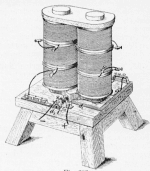Permanent Magnets
Permanent magnets are known since ancient times. It took until the late middle
ages, before a first description of the properties of magnets was written
down. Magnets wre known at that time only from natural origin (often meteorite
oar, which made them rare and expensive). These magnetic stones were clad
with iron balls and thus gave the so-called lodestones. In 1269, Pierre de
Maricourt wrote his famous epistola de magnete, which subsequently
was circulated in at least fifty hand-written copies. It clearly described
the attracting an repelling forces of a magnet. Pierre also found out that
there are two different types of poles and defined for them the names
north and south pole.
| ***image*** |
Whenever the word magnet is mentionend, many people have the classical
horse shoe magnet in mind. This type was made of several separate layers
of steel, which were magnetized separately. Then they were combined to form
a stronger magnet. An old book on experimental physics gives these data about
the forces for permanent magnets:
(Units transcribed into modern units) |
| ***image*** |
Today, horse shoe magnets are rare and normally only sold as toys. Modern
engineering demands other types and shapes and modern technology provides
many variants of permanent magnets. Today's high-force magnets are not made
of steel but of alloys like the famous AlNiCo. These magnets are considerably
stronger than the classical mentioned before:
|
Magnets seem to be a mystery even today due to their ability to cause forces
on remote iron objects.
Modern magnats are not made by rubbing a steel bar on a permanent magnet,
like this was done until the end of the nineteenth century. Making magnetic
material is a science of its own, and the manufacturers guard their secrets.
Normally, high-force magnets are produced by applying a very strong magnetic
field onto the molten alloy and then cooling it down in a defined way. Because
of the technical effort and complexity of the process, these magnets aren't
cheap.
Electromagnets
 |
|
An electro magnet basically consists of a coil made of wire. If current
runs through the coil, a magnetic field is generated. The field strength
depends from the number of windings of the coil, voltage and current and
if the magnet has an iron core or not. An argument frequently issued by perpetual
motion inventors, who compare permanent magnets with electromagnets of the
same force runs this way: "The permanent magnet works for free. The electro
magnet consumes power to produce the same force. This energy consumption
can add up considerably over time. Thus the permanent magnet has an advantage
over the electromagnet due to a hidden secret physics cannot explain or
scientists are unwilling to reveal."
This sounds very convincing, but is simply wrong, at least for electro magnets
powered by DC. If you unwind the magnet, throw the whole ratsnest randomly
onto the ground, and then apply current, you will learn that it consumes
the same power, but does not generate a magnetic field worth mentioning.
Now: what is the reason for the difference between permanet magnet and electro
magnet? The reason is electric resistance of the wire. If you had a wire
with no resistance, you could power up the magnet and then disconnect it
from the power supply after you closed the loop. This is no science fiction
idea, but can be demonstrated in many laboratories all over the world. The
magnet I've written of, is based on superconduction. |
The main advantage of an electromagnet is the possibility to control its
force.
Transformers
Up to now, I've written about electromagnets powered by DC.
As transformers and electrodynamic machines are closely connected, you will
find more material in the electrics section.
Magnetic Floating
For a long time, the opinion was that with static magnets a floating device
cannot be built. With electromagnets and some electronic trickery, it is
possible to keep a ferromagnetic object floating in the air by magnetic forces.
The discovery of the effect on which the floating gyro "levitron" is based,
came as a little surprise. This device is made of permanent magnets!
***image***
Funny enough, there is a report by Pliny the Elder from 79ad. Pliny mentiones
a temple, where in a niche an iron statue is freely floating hold by the
forces of magnetic lodestones.
Magnetic PMMs
Early suggestions were already made by Pierre de Maricourt, but the time
when magnetic perpetual motion devices were extensively suggested, is the
seventeenth century.
Further Reading
If you are interested in experiments with magnets, check the magnet man home
page. The author has profound knowledge and offers a very wide range of magnetic
experiments and some theory.
A good historical review can be found at yyy of the university of yyy.
